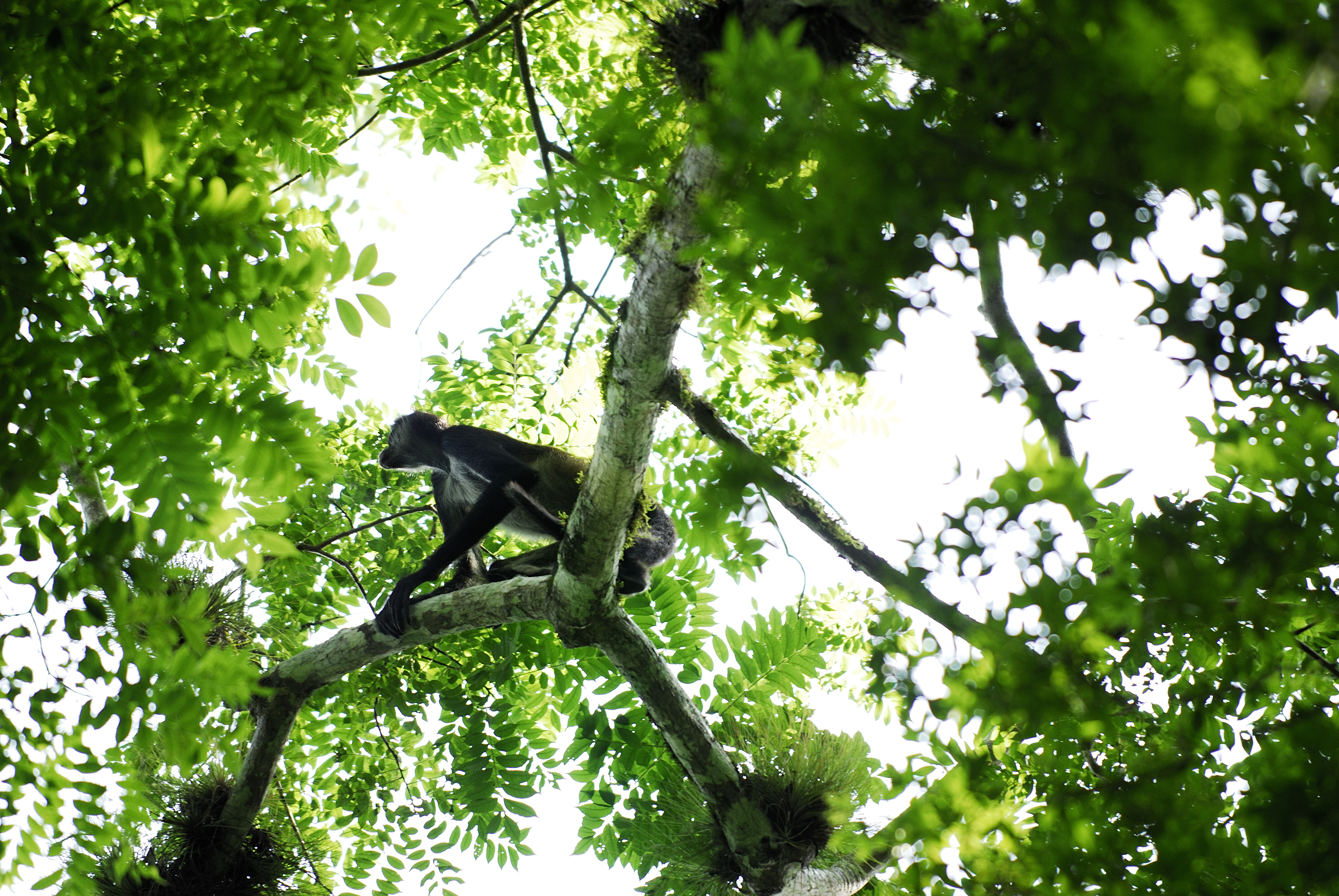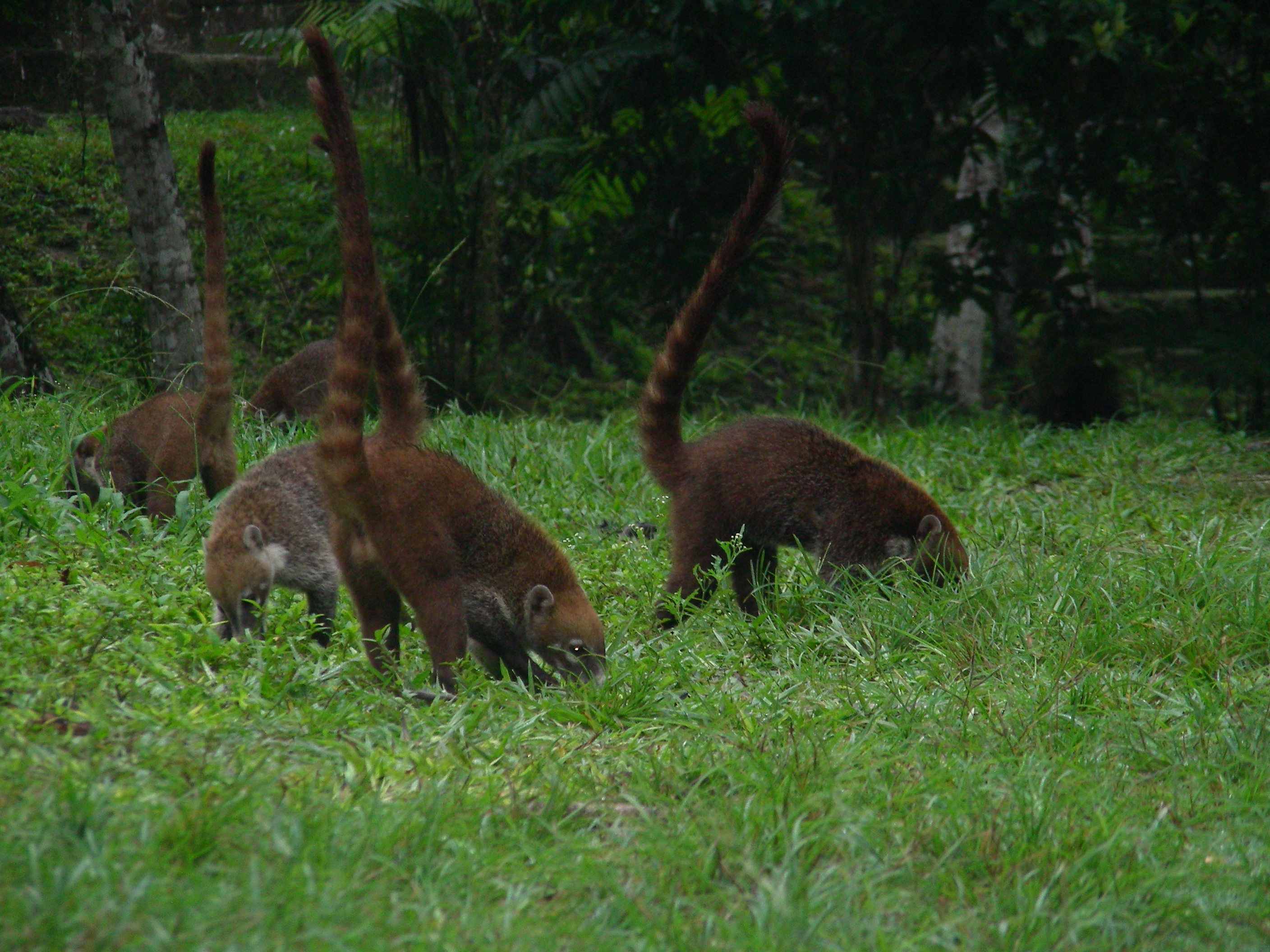
| Tikal Scientific Information Center | Tikal's Meteorological Information |
| Tikal's Hydrology | Tikal's Ecology | Tikal's Flora | Tikal's Fauna |
| Tikal's Mammals | Tikal's Felines | Tikal's Bats | Tikal's Birds | Tikal's Insects | Tikal's Reptiles | Tikal's Amphibians |
| Tough to Spot |
Resident Mammals at the Tikal National Park in Guatemala
Mexican Black Howler Monkey
Order: Primates
Family: Cebidae
Species: Alouatta pigra
The Mexican Black Howler Monkeys are entirely black, their hair long. Scrotum of males over 3-4 months old is white and prominent. Their shoulders are robust, hind-quarters disproportionately small and weak-looking, while their tail is prehensile and often carried in a coil. They are similar to the mantled howlers (Alouatta palliata) in that both have a pale saddle or fringe on the sides. Central American spider monkeys (Ateles geoffroyi) living in the same area are brown or silvery with pale bellies and pale masks around eyes.
The howler monkeys’ roar is a loud chorus of howling, usually lasting many minutes, especially at dawn, late afternoon and during rainstorms. Howling starts as an accelerating series of deep grunts made by the male, which grades into long, deep, roars. The females join in with higher-pitched roars. In alarm, one monkey in the group gives a few soft grunts. They are diurnal, arboreal and their groups are conformed of 1 to 10, usually 4 to 6 members.
They feed on fruit and leaves. These monkeys can often be seen in forests around archaeological sites. Their behavior apparently is similar to that of other howlers found in evergreen and riverine lowland forests. They are located in Central America, the Yucatan Peninsula, Guatemala and Belize. They are threatened by deforestation and hunting for meat, and some populations may have been decimated by yellow fever epidemics. (CITES Appendix I, US-ESA endangered)
Their local names are Mono aullador and saraguate in Spanish; it’s called a baboon in Belize, and receives the name batz in Mayan!
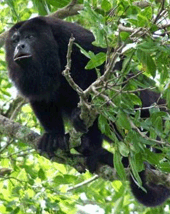
Black Howler Monkey, Alouatta pigra
Spider Monkey
Order: Primates
Family: Cebidae
Species: Ateles geoffroyi
Their black, brown or reddish upper parts identify the spider monkeys. Their face often has a “mask” of pale unpigmented skin around the eyes and muzzle. Its forearms, lower legs and feet are usually black or dark. Its under parts are usually paler than black, white, pale brown, reddish or buff, but black in some populations. Spider monkeys are highly variable both individually and geographically.
Their range is all throughout Central America; both coasts of South Mexico to South Colombia, Darien and Panama, west of the Andes and Central Ecuador, and the northern coast of Colombia and Venezuela. They are threatened by deforestation and fragmentation of their geographic range and by hunting for meat. May also suffer from yellow fever epidemics. Spider monkeys seem to need large areas of unbroken forest for survival. (CITES Appendix I)
Their sounds are loud, prolonged screams that can be heard for long distances, short quavering whinnies heard at close range; in alarm, they bark like a pack of dogs. They are noisy travelers that make long, crashing leaps through the canopy. They are diurnal, arboreal and move in groups of 1 to 35 members; members of large groups frequently split into smaller groups to forage. They feed on ripe fruits, with a few leaves and flowers. The locomotion, reproduction and behavior of Central America spider monkeys are similar to those of black spider monkeys, except that a female may have young every 2 to 4 years. They are found in mature rainforest and deciduous forest.
Spider Monkey is also called: mono araña, mono Negro, marimonda, brasilargo and mono colorado in Spanish, and yerré and maax in Mayan.
White- nosed Coati
Order: Carnivora
Family: Canidae
Species: Nasua narica
White-nosed coatis are identified by dark brown upper parts and shoulders or grizzled gray forequarters. Its head is sometimes rusty brown; and their muzzles and chins are white, extending as a white stripe above the eyes. They may sometimes have other white spots above and behind the eyes. Their ears are short and lined with whitish fur. Their tail is between 75 and 100% as long as the head and body, thickly furred but not bushy, tapering at the tip, dark brown with paler rings usually inconspicuous to invisible. Their feet are dark brown, and their forefeet often contrast with their gray shoulders. Their throat and chest are frosted white, their belly dark brown or frosted white. Their forefeet have long claws, and their hind-feet strong, curved claws.
There are similar species, such as raccoons (Procyon cancrivorus), which have black masks, short tails and normal snouts. Another close relative is the Olingo (Bassaricyon sp.), which is much smaller with no facial markings. The tails of spotted cats may be held vertically and resemble those of coatis in the undergrowth, but cat's tails are not tapered and are irregularly spotted with pure black and white.
Members of active groups emit constant soft whining sounds; while their alarm calls include explosive woofs and clicks. The white-nosed coati is diurnal, terrestrial and arboreal; may lead a solitary existence or may live in groups of up to 30 individuals. They are omnivorous, feeding on fruit, invertebrates, and other small animals. Coatis can be seen feeding on fruit high in the canopy or searching the forest floor for animal prey by poking their long noses into crevices, turning rocks over, or ripping apart dead logs with their claws.
Coatis sleep in a treetop by night. Females leave the group when they give birth to young which are raised in a nest in a tree. Found in forested habitats ranging from tropical rainforest and gallery forest to Chaco, cerrado and dry scrub, coatis live in North, Central and South America.
The white-nosed Coati is also called Quash, cusumbo, cusumbo solo, gato solo, pizote, pizote solo, tejón, cuchucho and andasolo in Spanish. They are locally common to rare. (CITES Appendix III)
White- nosed Coati, Nasua narica
Paca
Order: Rodentia (Rodents)
Family: Agoutidae
Species: Agouti paca
Paca are identified by their chestnut red or dark brown upper parts, their sides from neck to rump have three or four lines of large white spots sometimes coalescing into stripes. Their hair is coarse, sparse, and flat. Their head large, their cheeks swollen, they have short brown ears, their whiskers are long, and their eyes large and widely spaced, with a bright yellow to orange eye shine. Their tail is a tiny stump hidden beneath their rump hair. Their lower cheeks, throat, chest, and under parts are white. Their forefeet has four toes, the hind-feet have three large toes and two tiny toes that usually do not touch the ground. They have heavy, pig-like bodies, with a large rump. The young resemble the adults.
They are similar with pacaranas (Dinomys branickii), baby tapirs (Tapirus sp.), and baby deer (Mazama, Odocoileus sp.) another paca species. Pacas walk heavily and noisily in dry forest-floor leaves. In alarm they usually do not call; they give a hoarse bark or make a deep rumbling sound by grinding their teeth rarely. The head is modified with expanded cheekbones and pockets in the cheeks that probably act to resonate this sound, which seems to be a social signal.
They are nocturnal, terrestrial, solitary and are rarely seen in pairs. They feed on fallen fruits, browse, and some tubers, such as malanga. Pacas are most common near water, from large rivers to small seeps, and in swampy areas and dense thickets, where they forage alone.
Found in mature, disturbed, and secondary rainforest, montane forest and gallery forest, gardens and plantations. Pacas are the most prized Neo-tropical game animals for their tender, veal-like meat, and they are easily hunted by day with dogs or at night with headlights and are now scarce or locally extinct in over-hunted areas. It is not uncommon to see them in the menu or that they are offered as a main course and delicatessen in local restaurants, to save this species, we strongly advise you not to consume jungle meat or tepe dishes. Where they were little hunted they are common and easily seen. Because of their huge geographic range and liking for inaccessible swamps, thickets, and second growth and lowlands pacas are not threatened except locally, especially in Central America and particularly in the Peten. Efforts should be made to manage this species for sustainable hunting yield from intact forests, where they are part of the local diet. (CITES, Appendix III)
Their local names are Paca, jochi pintado, sari, paca, guagua, lapa, guanta, in Spanish, while Mayans call them pak. However, in the Peten they call them tepezcuintle or tepe, for short, while they receive the names of gibnut or water haas in Belize!
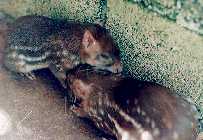
Tepezcuintle or lowland paca, Agouti paca
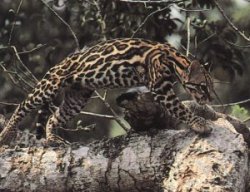
Tikal ocelot, Leopardus pardalis, huntings its prey.

Mammals: Mammals are endotherm (warm-blooded) animals. They have hair or fur, females secrete milk for the nourishment of their young, and typically birth live young offspring.
The first small mammals probably evolved from a common ancestor with sauropsids (reptiles, birds and dinosaurs) about 200 million years ago, and the group diversified rapidly after the extinction of the dinosaurs to become the dominant form of land animal, with around 4,000 living species. Mammals belong to the class "Mammalia", which contains the subclass "Prototheria" (monotremes) and the cohorts "Metatheria" (marsupials) and "Eutheria" (placental mammals such as rodents, cats, whales, bats, and humans).

We hope you will enjoy www.tikalpark.com and its Spanish version www.parque-tikal.com
For reservations or more information write to us at tikalpark@tikalpark.com.


| Home | Arts | Sciences | Transportation | Lodging | Special Tours | Birding Tours | Tours | Map | About Us | e-mail us | Site Map |
